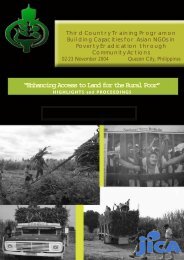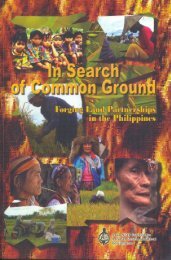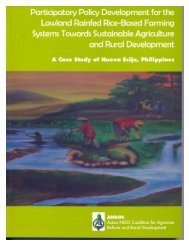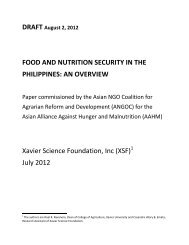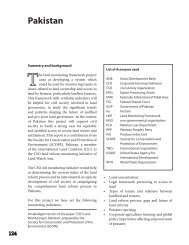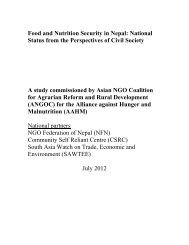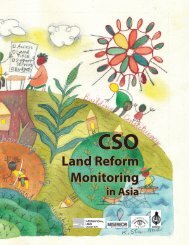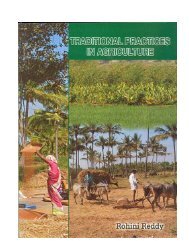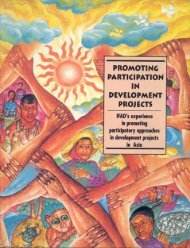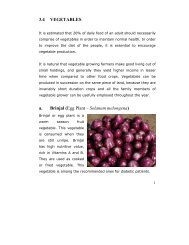Securing the Right to Land FULL - ANGOC
Securing the Right to Land FULL - ANGOC
Securing the Right to Land FULL - ANGOC
Create successful ePaper yourself
Turn your PDF publications into a flip-book with our unique Google optimized e-Paper software.
Table 1. con’t.<br />
Philippines<br />
Features of <strong>Land</strong>lessness<br />
THE PROLONGED STRUGGLE FOR LAND RIGHTS IN ASIA<br />
15<br />
The Philippine agrarian structure is made up of small peasant farms and large plantations.<br />
Over 31 million poor Filipinos are found in <strong>the</strong> rural areas. Poverty incidence remains highest among<br />
farming and fishing families. Within agriculture, it is farm workers in sugarcane, small farmers in coconut,<br />
rice and corn, fishermen and forester households who are among <strong>the</strong> poorest of <strong>the</strong> poor and who<br />
account for 70% of <strong>the</strong> country’s subsistence households.<br />
Between 1.3 and 1.5 million hectares of farmlands remain undistributed <strong>to</strong> farmers. Potentially 1 million<br />
farmers are deprived of <strong>the</strong> chance <strong>to</strong> benefit from agrarian reform.<br />
It is estimated that 5–7 million hectares will be covered by <strong>the</strong> Indigenous Peoples <strong>Right</strong>s Act (IPRA)<br />
under ancestral domain claims or titles. Slightly more than half a million hectares have been awarded <strong>to</strong><br />
indigenous peoples as ancestral domains.<br />
Community-managed forests only cover 22% of <strong>to</strong>tal forest cover.<br />
Barely half of coastal <strong>to</strong>wns have effectively delineated municipal waters for small fisherfolk.<br />
Almost 85% of fisherfolk are threatened by eviction.<br />
Legislative and Policy Initiatives<br />
for <strong>the</strong> Promotion of <strong>Land</strong> <strong>Right</strong>s<br />
In all six countries, laws have been passed, and policies formulated,<br />
in regard <strong>to</strong> reforming land ownership and agrarian structures.<br />
Such reform initiatives can be grouped in<strong>to</strong> two<br />
“generations” of reforms: <strong>the</strong> first, which go back <strong>to</strong> <strong>the</strong> 1950s;<br />
and <strong>the</strong> second, which started in <strong>the</strong> 1990s.<br />
“First Generation” Reforms<br />
One of <strong>the</strong> most common “first generation” reforms was <strong>the</strong><br />
establishment of ceilings for landholdings. Between 1950 and<br />
1984, Bangladesh vacillated about <strong>the</strong> maximum size of landholdings<br />
that families could legally possess, raising it <strong>to</strong> 50<br />
hectares, at its highest, and eventually lowering it <strong>to</strong> eight<br />
hectares. Never<strong>the</strong>less, <strong>the</strong> government failed <strong>to</strong> recover “surplus”<br />
land, estimated at one million hectares, because of lack of<br />
political will. Similarly, India’s states individually imposed landholding<br />
ceilings between 1955 and 1985, with mixed success.<br />
About a million hectares of “surplus” land was recovered by <strong>the</strong><br />
government in 1970, half of which reverted <strong>to</strong> <strong>the</strong> states, while<br />
<strong>the</strong> remaining half was distributed <strong>to</strong> <strong>the</strong> landless. However,<br />
between 1972 and 1985, and despite <strong>the</strong> lowering of <strong>the</strong> ceiling,<br />
<strong>the</strong> size of <strong>the</strong> “surplus” land recovered by <strong>the</strong> government<br />
had increased by just 10 percent over <strong>the</strong> 1970 figure.<br />
A second type of reform was <strong>the</strong> abolition of, or <strong>the</strong> efforts <strong>to</strong><br />
eliminate, <strong>the</strong> practice of absentee landownership. The 1950<br />
law passed by <strong>the</strong> Indian state of Uttar Pradesh abolishing <strong>the</strong><br />
zamindari, or absentee landlord system, was one of <strong>the</strong> first<br />
laws of this kind. Bangladesh sought <strong>to</strong> put an end <strong>to</strong> absentee<br />
landownership by prohibiting <strong>the</strong> sub-letting of land. Indonesia<br />
proscribed <strong>the</strong> practice because it resulted in <strong>the</strong> exploitation of<br />
tenants, usury, and unjust sharecropping arrangements.<br />
But perhaps <strong>the</strong> most important type of reforms in this group<br />
had <strong>to</strong> do with changes in <strong>the</strong> relationship between landlord<br />
and tenant, and in some cases, <strong>the</strong> abolition of tenancy. Nepal’s<br />
six types of tenurial arrangements, which date back <strong>to</strong> 1946<br />
and persisted well in<strong>to</strong> <strong>the</strong> 1970s, are infamous for <strong>the</strong>ir exploitative<br />
nature, as exemplified by such practices as bonded<br />
labor—usually exacted <strong>to</strong> pay off debts, arbitrary eviction of tenants,<br />
and collection of unreasonably high land taxes and rents.<br />
The Nepalese government sought <strong>to</strong> improve <strong>the</strong> lot of tenants,<br />
through <strong>the</strong> <strong>Land</strong> Reform Act of 1964, by abolishing dual ownership<br />
of land, or rented tenure arrangements, and by fixing <strong>the</strong><br />
rent on agricultural land. Indonesia passed a law in 1960 <strong>to</strong> protect<br />
sharecroppers from exploitation by landowners, particularly<br />
by requiring that sharecropping agreements be put in writing<br />
and signed by <strong>the</strong> parties before <strong>the</strong> village head, and have a<br />
fixed duration, thus precluding arbitrary changes imposed by<br />
<strong>the</strong> landowner. Bangladesh made provisions <strong>to</strong> res<strong>to</strong>re <strong>the</strong> rights<br />
ASIAN NGO COALITION FOR AGRARIAN REFORM AND RURAL DEVELOPMENT



